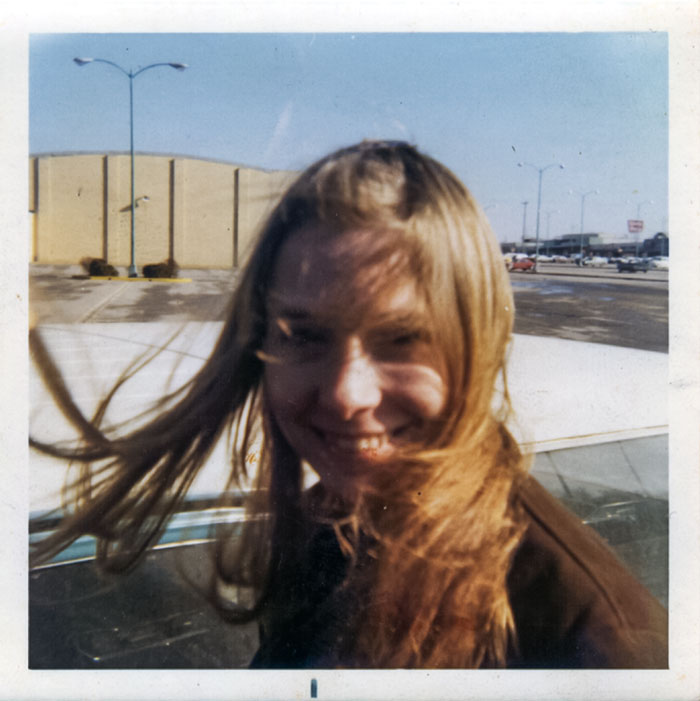
With Kathy at Graceland Mall
Kathy got dropped by her boyfriend right about the time I broke up with Kay. We consoled each other.
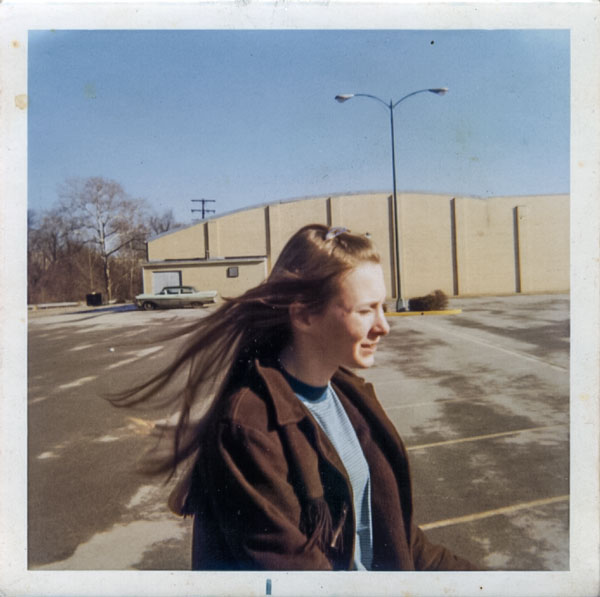
 years
years

Kathy got dropped by her boyfriend right about the time I broke up with Kay. We consoled each other.

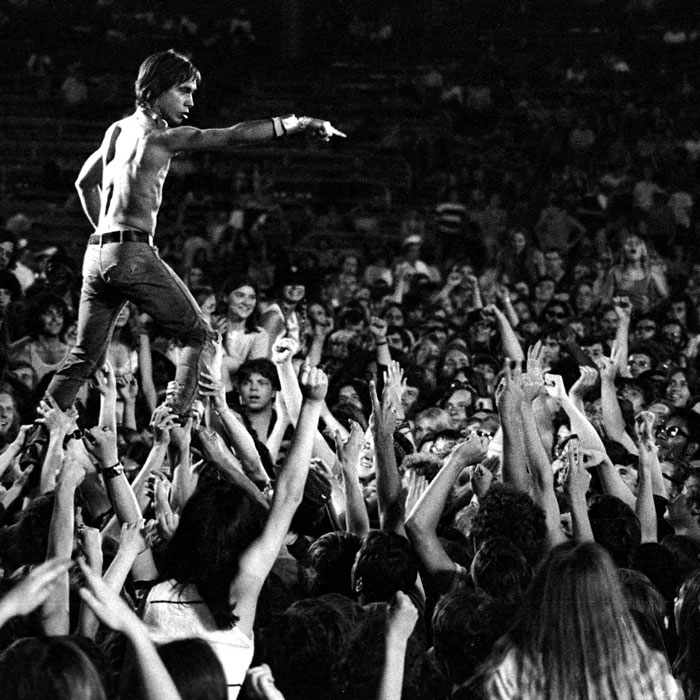
Early in the summer of 1970 I bought tickets to something called the Cincinnati Pop Festival. Woodstock had happened just a few months before and every concert promoter in the country was anxious to cash in on all that peace and love. In this case it was a couple of guys out of Detroit who booked a lot of Michigan acts, which is how The Stooges, The Bob Seeger System, and Alice Cooper made it into the lineup. Though Seeger played Columbus frequently (at a club called The Sugar Shack) I’d never heard of the other two acts. In hindsight I’m surprised the MC5 weren’t booked, too.
The Pop Festival turned out to be the site one of rock’s iconic moments, when Iggy Pop walked out over the crowd held up by their outstretched arms. It was like Jesus walking over the water, if Jesus had dropped acid and smeared peanut butter over his naked chest. Iggy did both; lo, a new Messiah appeared.
Tickets cost me seven dollars; I bought two, one for me and one for my friend Kathy. We saw many shows together around this time. I particularly remember seeing Janis Joplin and later Donovan at Veteran’s Memorial Auditorium, and a Chairman of the Board show at the Ohio State Fair. Most of the acts that made it onto a label eventually played Columbus.
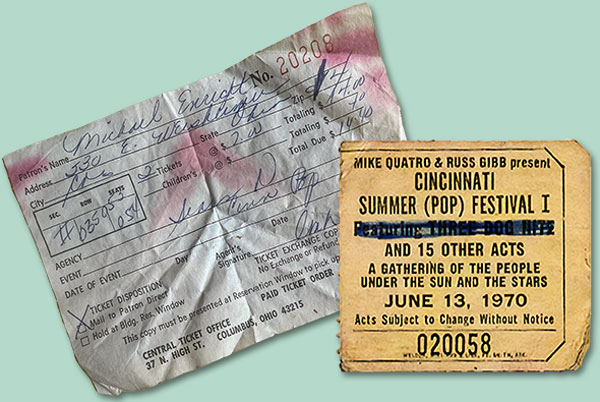
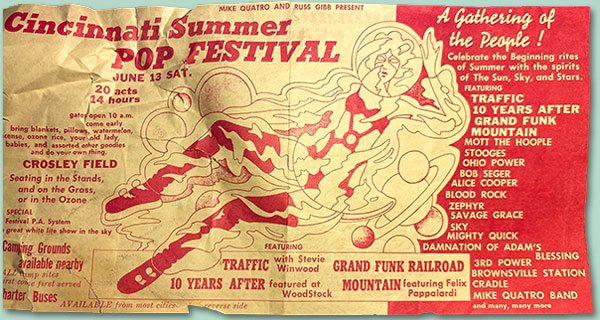
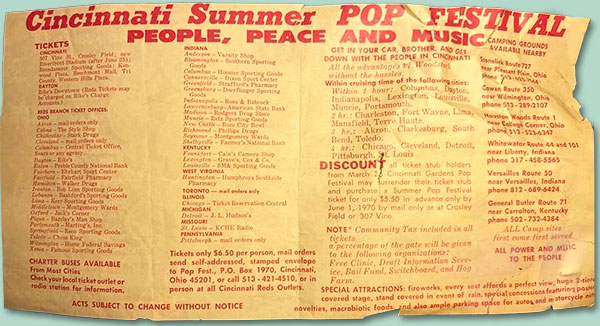
The show was at Crosley Field, the soon-to-be-closed home of the Cincinnati Reds. Though there were only two more home games to play before the place was permanently shut down, Redlegs management was intensely concerned with protecting a few square yards of their infield grass. Since the stage was out at second base, a very long way from the crowd, there was a lot of turf to protect. The hundred or so cops assigned to the show had a hopeless and unrealistic job. They put up an improvised fence along the first and third base lines and stationed a few guys there; that would surely stop anyone from climbing over the barricade and getting closer to the musicians. This is where the trouble started.
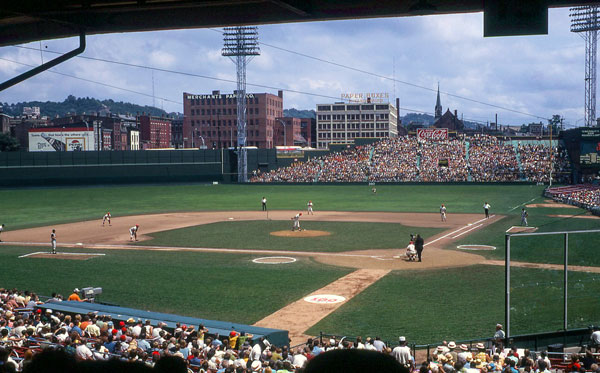
Before describing what went wrong one must understand the deep suspicion the crowd had for the cops and the absolute hatred the cops had for us. I suppose I shared the audience view of the cops; we'd seen a lot of pictures from Selma and so many other places. Complicating our stance was the fact the most of us were law-breakers: we had a fondness for weed. Indeed all those drugs we were doing were illegal. Youth in the eyes of the law equalled dirty and shirtless long-haired guy with a joint; cop in the eyes of the youth equalled racist cartoon with gun, dog, and big stick.
Michigan trio Grand Funk Railroad tore the place apart. I wasn’t particularly interested in the band but they were obviously putting on a great show. (Homer Simpson says they are his favorite band.) Shirtless Mark Farner, the lead guitarist, was being rock star incarnate. They didn’t call it shredding back then but that’s what he was doing, really fast blues-based riffing over a loud and powerful beat. At some point the band began gesturing to the crowd to come closer. There had been sporadic solo attempts to jump the fence throughout the afternoon followed by sometimes brutal police reaction. “Come on!” the band yelled, or something very much like that.
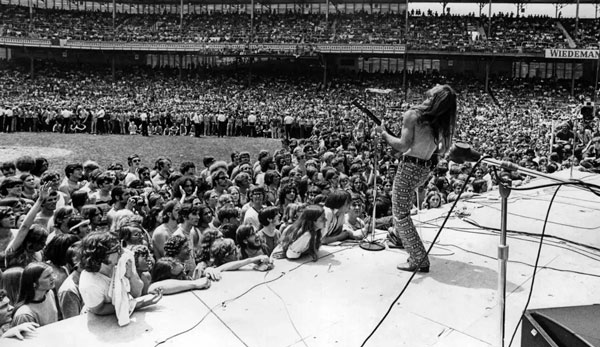
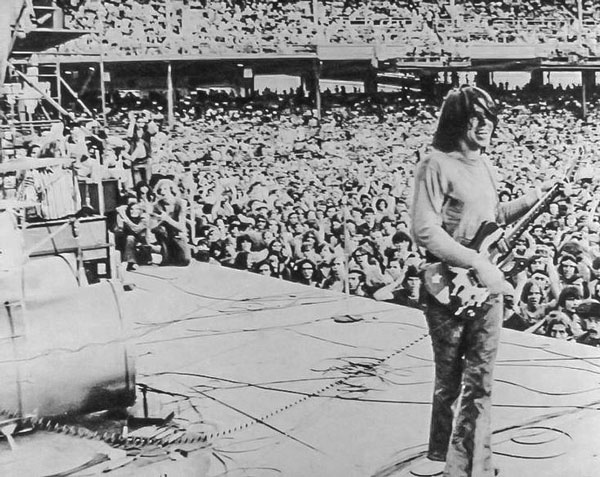
So the massed youth behind the fence broke over the barricade like the ocean breaking over rocks on a shoreline. There was a stampede and the infield grass became invisible under a sea of midwestern teens; the hippies danced on the pitcher’s mound. I think both sides saw the breakthrough as an act loaded with youth-revolt symbolism. For the rest of the set the crowd danced where they were and the cops did nothing.
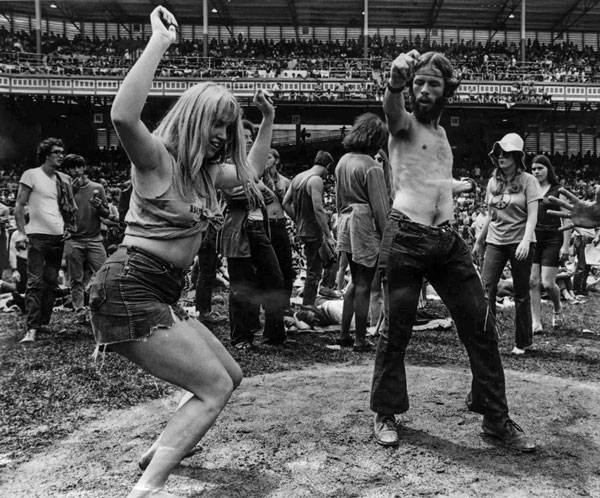
I was sitting in the stands with Kathy watching this all from uncomfortable baseball stadium seats. It was an ideal place to observe the ebbing and the flowing. For the rest of the afternoon and the evening, the show would come to a temporary halt between sets and the crowd would be cleared out with the announced threat of stopping the show. Then during the following set, particularly if it was a hard-rocking band, the crowd would break through again. (They didn’t bother when it was Traffic doing The Low Spark of High Heeled Boys
.)
I made my own way down to the front of the stage during the Mountain set, the band I’d come to see. I got pretty close to the band. After a while I got tired of the sun and the standing and made my way back to the seats. The concert was locally televised and years later sold as a VHS called Midsummer Rock. I picked up a copy and was surprised to see my high-school-self grooving to Leslie West.
After each of these interruptions the police presence would become more obvious, until finally there was a solid line of cops lining the base paths. They held that position until the very end of the show. From the crowd came bottles, cups, hot dogs, hard-boiled eggs—whatever else could be found in the cooler. It became tense. One thing that has been forgotten about the 60s was how rock could feel dangerous; I didn’t get that feeling again until punk broke out.
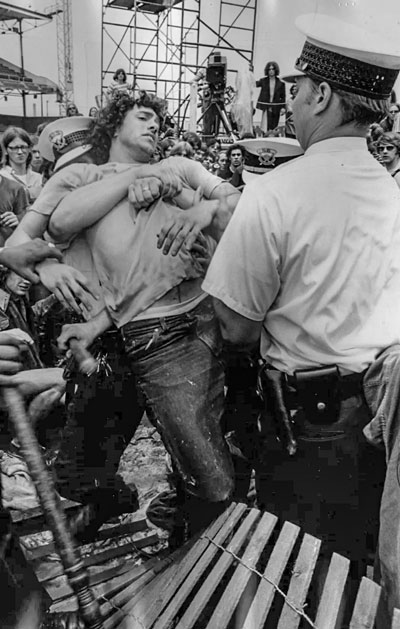
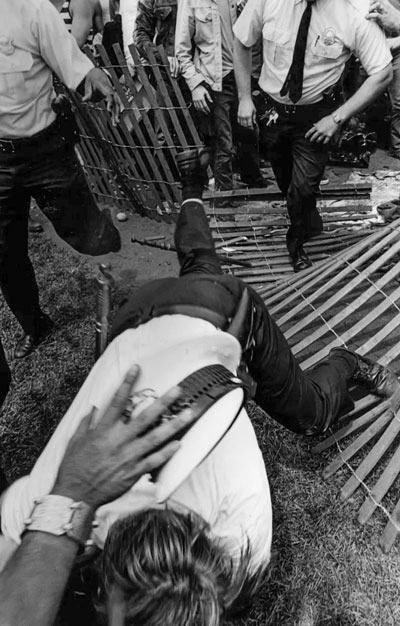
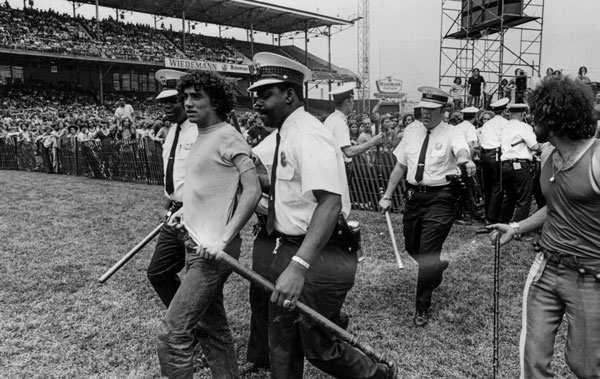
Finally the show was over and we all began to head for the exit corridors beneath the stands. I’m not sure exactly when or where it started but all of a sudden the cops seemed to feel it was payback time. “Police riot” is the phrase I would use. There was chaos and panic in the concrete tunnels as we ran for the exits. People a little slower than us were thrown to the ground and beaten with billy clubs.
Seventy-four arrests were made. According to the official report. “Police had to use force to control youths who hurled bottles and rocks. Twelve rock fans that resisted arrest were given hospital treatment. A number of police were injured. Nine required hospital treatment.” As we ran into the parking lot, there were indeed bottles flying over our heads, aimed at the cops behind us. It was surreal—a bad dream, a war movie.
A minute later and much further into the parking lot there were no more police; I'm guessing they were too busy working on the heads of those back near the stadium. I’ll bet the cops were praised at length in the Enquirer; Cincinnati heroes, no doubt. A year or so later I moved to the town myself and read that paper every day. I never believed police accounts about anything after the Pop Festival.
It’s a good policy to never bet your life on eye-witness testimony—from anybody—but that’s how I thought it went down. A few days later and the Reds left Crosley Field forever.
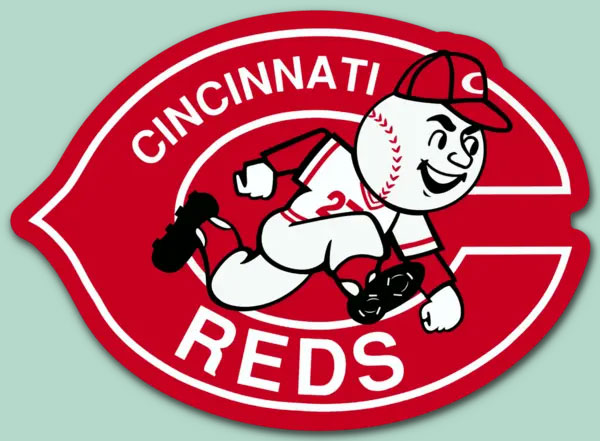
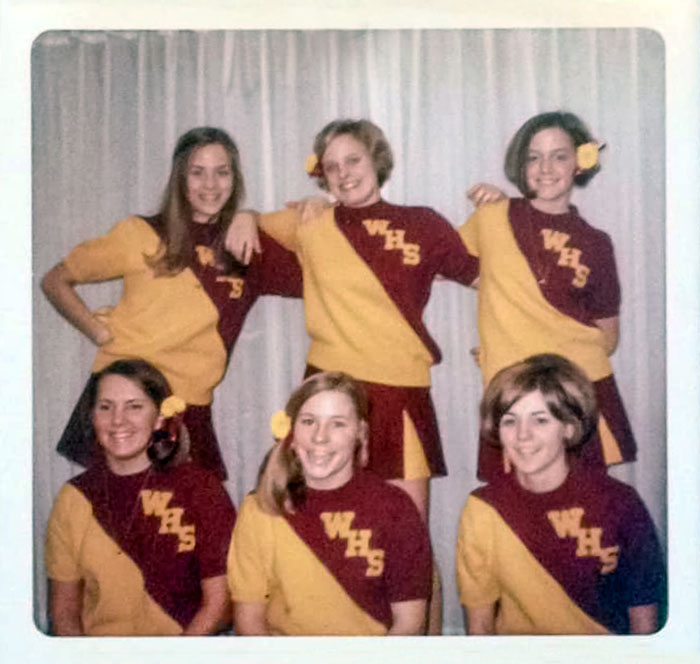
In senior year I dated a cheerleader (though not one of the girls here). Occasionally there would be a brief connection between the freak world I inhabited and the high-school status quo, though most of these connections didn't last long. After all these years Martie on the bottom-right remains a FB friend.
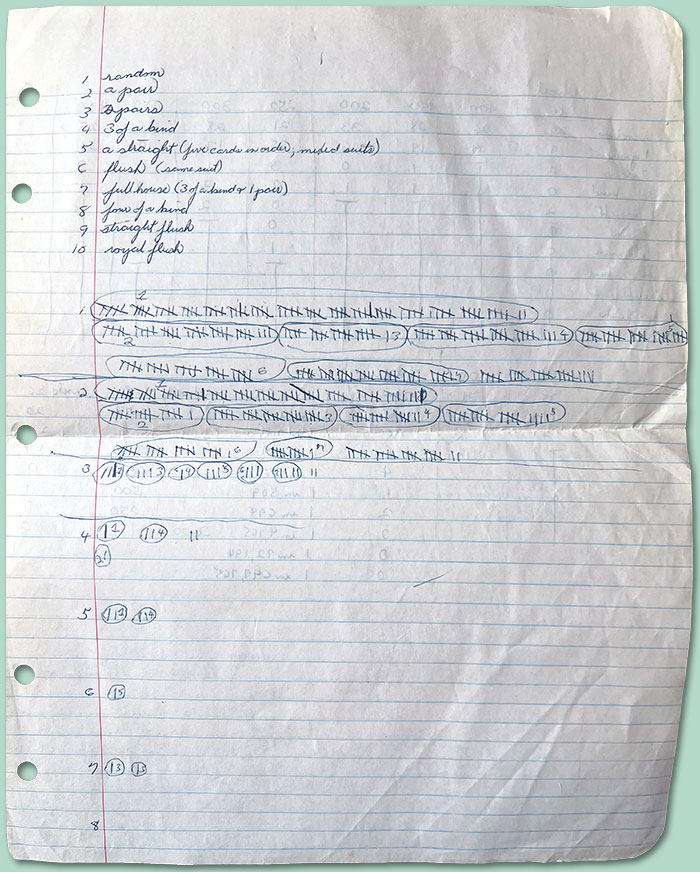
We moved into a smaller apartment earlier this year and have been attempting Swedish death cleaning in the process. The idea is to get rid of all the crap you accumulate in your lifetime, so as not to burden your descendants when you “Exeunt, pursued by a bear.” In contrast to my partner I have accumulated more than many, most particularly LPs, 45s, books, photos, audio equipment, and miscellanies. I have been world class with the miscellanies; now I try to photograph any that might be useful here and then stick them in a box and forget them.
Or in this case, present. The picture above is page one of my notes on an assignment in a biology class. As much as I am infatuated by science, I am incompetent in the nuts and bolts of theory, particularly when translated into mathematics. For me even arithmetic is challenging; I’ve come to accept the obvious concept that rote learning and memorization are essential to fluency in math. I am not fluent; I did not memorize. A good example: I was the last in my grade school class to establish a firm syntactic structure for the times tables.
In the 80s and 90s I consulted with a talk therapist so that I might find my way to a happier life. Depression had followed me from my early years. My mother was often depressed and there is undoubtedly a genetic component; my father self-medicated to the point of alcoholism.
Sylvia was my therapist; I met her one night in my cab when I drove her to the home of all therapists in New York, the Upper West Side, She gave me her card. She also gave me the gift of a sliding-scale for payment; I always gave her something but particularly in the early years it was a very modest amount. I’m not sure we ever solved anything, if that’s even the goal of talk therapy. It’s not like the end of Spellbound or Marnie; there is usually no repressed memory to recover. Traumatic memories are hard to repress; people spend their lives wishing they could do so.
I did find it gratifying to spend hours and hours talking about myself; if you’ve read any of the other items on this site, you know how much I enjoy my own past. The selfish joys of the examined life!
Sylvia helped me get out of the taxi business. With her common-sense advice I found my way to a temporary per diem teaching certificate (the TPD) and a job at a junior high school two blocks from where I lived. Every step of the process was terrifying—particularly those first days in the classroom with a bunch of kids from the projects—but she never stopped encouraging me. I think it saved my life. I was one step away from slipping into some sort of addiction; my financials were incomprehensible; my mental stability was as insecure as my balance in the senior years I am enjoying now.
There is no such thing as laziness, Sylvia insisted: it was resistance. It’s a useful way of looking at things one can’t bring oneself to do. Instead of just calling myself lazy, and then feeling the accompanying shame and guilt, I would try to discover why I didn’t want to do whatever it was I was putting off and then find some way of doing it. Paying bills, for instance, or writing letters, or looking for a job, or seeing a dentist. Later when I was a consultant with clients, sending an invoice.
Which brings me back to arithmetic. Why was I so resistant to the times tables? I have a theory which some find laughable, particularly those who don’t have the same trouble. I think I have a neurological problem with numbers. Not the concepts behind the numbers; when I took the SATs I got a decent math score by drawing all the elements of a word problem on a scrap of paper. It’s not a very efficient technique and takes longer, but the reasoning is sound and I eventually arrived at a correct answer.
Later in life I became a decent programmer, and programming problems are like algebra problems and require the same type of logic. In a black-box situation—you have the input numbers and you need the black box to do something with those numbers and spit out the results—I would explain the issue to Carolyn (who is brilliant at this, by the way) and she would supply an equation. I’d stick the equation into the black box and everything worked. I knew exactly what I needed but didn’t have the arithmetical skills to build the equation.
Somehow it was the numbers themselves, or their algebraic equivalents—as soon as I encountered a number, my consciousness went elsewhere. I read a lot of hard
science-fiction, much of it written by working scientists, and if an equation enters the paragraph I examine it briefly and move on, confident the following text will tell me what the equation might have.
(I am reminded of the interminable passages of poetry in an otherwise excellent book, A.S. Byatt’s Possession. By the end of the novel I was skipping most of long poems she had devised; her renditions of Victorian poetry were so accurate that I found myself reacting the same way I had to Byron.)
This has all been a windy explantation for the picture you’ve seen at the top of this item. I was faced with a biology assignment that required me to deal with probability. It had something to do with genetics and the likelihood of inherited traits. I loved learning about this stuff; the mechanics of evolution immediately made sense to me. I thought to myself that god didn’t play dice with the universe; god played poker. (Thinking about it now I realize dice would have worked just as well.)
There are probability tables stored in the easy-access parts of the brain of any good poker player. Professionals follow these tables and win. My thought was to prove empirically that the tables were real. I would deal myself a thousand hands of poker and tabulate the results. With a thousand hands it worked; it has to be a least a thousand hands for the odds to conform to the predictions. The results of each hand were recorded: three of a kind, straight, flush, etc. Final results can be seen in the crude table below. (If you have a way to increase the contrast on the image you might also observe, unfortunately, scrawled beneath the table in pencil, the lyrics to a song I was working on for months that year. They embarrass me; I've done better since.)
That’s how a relatively clever but limited brain ends up passing a high-school biology class. It didn’t work with Latin; I had to cheat to get through Latin.
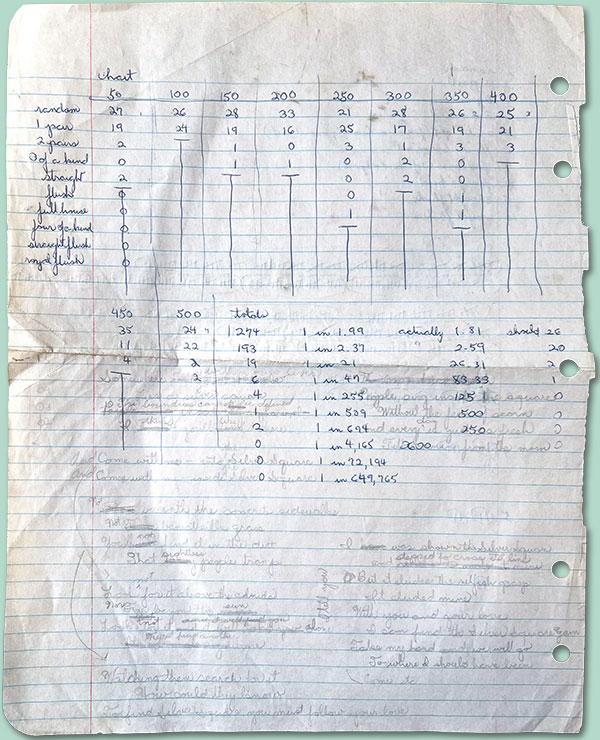

Pensive Mood,bought in a junk shop and still hanging on the wall a half-century later.
